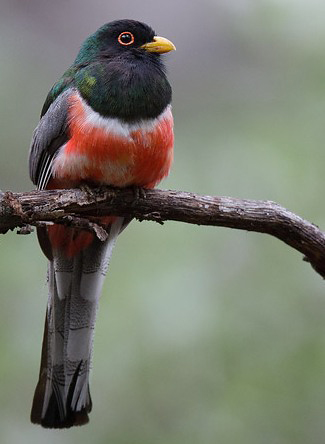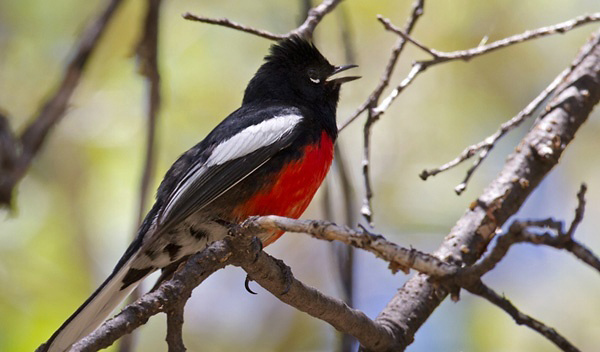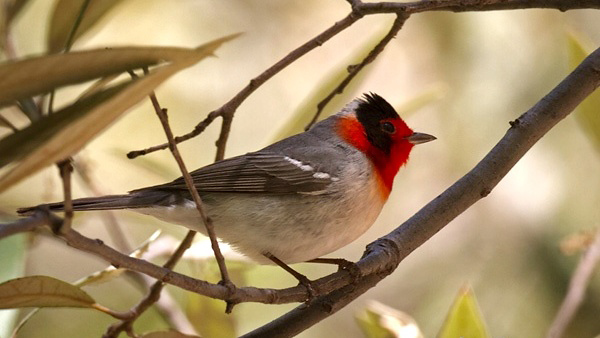

A beautiful male Elegant or Coppery-tailed Trogon in Madera Canyon by Michael McKee.
- A greater variety of breeding birds than any other area of comparable size in the United States; about 190 species
- Including Central and Southern American species with ranges extending north into the area, such as Common Black Hawk, Coppery-tailed (Elegant) Trogon, Buff-breasted Flycatcher, Mexican Chickadee, Painted Redstart, and Grace's, Olive and Red-faced Warblers, with the chance of rarer visitors including the likes of Aztec Thrush and Rufous-backed Robin
- Southeast Arizona is also the best place for nightbirds in North America with over ten owl species and at least three nightjars usually present and best looked for during May, including Elf Owl, Spotted Owl, Whiskered Screech-owl, Mexican Whip-poor-will and Common Poorwill
- May is also a good time to look for hummingbirds although late July-early August, during the 'second spring' which follows the beginning of the rainy season, is even better, a time when many can be seen at the numerous feeding stations, including Blue-throated, Magnificent and Violet-crowned
- Most of the hummingbirds (and trogon) leave during the winter when they are replaced by many Sandhill Cranes, Mountain Plovers, raptors and sparrows
- Supported by such classic ‘American’ birds as Gambel’s Quail, Greater Roadrunner, Vermilion Flycatcher, Cactus Wren and thrashers
- All a half-day by road from Tucson in largely flat deserts up through famous wooded canyons to spruce-fir forests on the cool heights of isolated mountain ranges known as ‘sky islands’, the most famous of which are the Huachucas and the Chiricahuas, the northernmost outliers of the Mexican Sierra Madre which support several Mexican species found nowhere else in the United States.
- There are so many birds different species are best sought at different times of the year and at least amongst well-travelled U.S. birders there are few who have not visited Southeast Arizona more than once. Some speciality birds can be seen during the Winter including Painted Redstart, Yellow-eyed Junco and Rufous-winged Sparrow, all of which are residents, but at this time of the year there are usually no trogons and only one regular hummingbird; Anna’s. Winter is a great time for raptors such as Ferruginous Hawk, thousands of Sandhill Cranes gather in the Sulphur Springs Valley and numerous sparrows visit the grasslands. Winter is also a great time for annual or near-annual Mexican vagrants including Ruddy Ground-dove, Rufous-backed Robin and Rufous-capped Warbler, as well as even rarer strays such as Aztec Thrush and Streak-backed Oriole
- During the Spring there is a good chance of seeing all the specialities including perhaps 9 or 10 species of owls (easiest to locate at this time of the year), 8 or more species of hummingbirds, Montezuma Quail, Coppery-tailed (Elegant) Trogon, Red-faced Warbler and Five-striped Sparrow, while possible vagrants include several hummingbirds.
- Although the best time for hummingbirds is the ‘Second Spring’. Each year, usually in the second half of July/early August, ‘monsoon’ afternoon rains start to fall and the deserts turn green. Some species wait to breed until the rains begin while others attempt a second brood at this time, including Montezuma Quail, and Botteri's and Cassin's Sparrows. On the other hand many of the nightbirds have completed their nesting and are less likely to be calling or singing and therefore unlikely to be located. The combination of breeding residents, rare summer visitors and early autumn/fall migrants means that a total of 15 hummingbird species are possible at this season. Anna’s, Black-chinned, Blue-throated, Broad-billed, Broad-tailed, Magnificent, Rufous and Violet-crowned can be expected. Allen’s, Calliope, Costa’s and Lucifer hummingbirds are less likely and post-breeding wanderers from Mexico include Berylline and White-eared Hummingbirds, as well as Plain-capped Starthroat.
- Northern Arizona is a beautiful part of the world thanks to the Grand Canyon, Monument Valley and other Red Rock formations, and therefore great country to bird in, in search of high-desert and mountain species, many not normally encountered in Southeast Arizona, including California Condor, which was reintroduced to the Grand Canyon in 1996, Lewis's Woodpecker, Mountain Bluebird, Clark's Nutcracker, Pinyon Jay and Mountain Bluebird, all of which may be seen within a short distance of Flagstaff. A top site for mammals is the Aubrey Valley west of Seligman where spotlighting at night may reveal Black-footed Ferret, American Badger, Collared Peccary (Javelina), Gunnison's Prairie Dog, Pronghorn, Coyote and Ord's Kangaroo Rat.

A cracking Painted Redstart in Miller Canyon by Lars Petersson.
Best Birds and other wildlife in Southeast Arizona
Birds
Resident Specialities
Montezuma Quail, Whiskered Screech-owl, Violet-crowned Hummingbird, Arizona and Gila Woodpeckers, Gilded Flicker, Bridled Titmouse, Mexican Chickadee,
Painted Redstart, Olive Warbler (most likely in spring), Abert’s Towhee, Rufous-winged Sparrow and Yellow-eyed Junco.
Also a chance of Eared Quetzal, Tufted Flycatcher, Black-capped Gnatcatcher, Aztec Thrush, Slate-throated Redstart, Flame-coloured Tanager and Streak-backed Oriole.
Summer Specialities
Common Black Hawk, Grey Hawk, Coppery-tailed (Elegant) Trogon (mainly summer), Greater Pewee, Buff-breasted, Dusky-capped and Sulphur-bellied (easiest
during ‘second spring’) Flycatchers, Thick-billed Kingbird, Red-faced Warbler and Five-striped Sparrow.
Also a chance of Buff-collared Nightjar, Berylline, Broad-billed (mainly summer) and White-eared Hummingbirds, and Plain-capped Starthroat (and fall).
Possible Winter Specialities
Ruddy Ground-dove and Rufous-backed Robin.
Resident Near-specialities (shared mostly with Texas and, in some cases, other southern states)
Black-bellied Whistling-duck, Scaled Quail, Neotropic Cormorant, Harris’s Hawk, Spotted Owl (‘Mexican’ lucida), Mexican Jay, Black-tailed
Gnatcatcher, Bendire’s and Crissal Thrashers, Phainopepla, Cassin’s Sparrow (easiest during ‘second spring’), Pyrrhuloxia and Bronzed Cowbird.
Also a chance of Rufous-capped Warbler and an outside chance of Ferruginous Pygmy-owl (endangered cactorum) and Green Kingfisher.
Summer Near-specialities
Zone-tailed Hawk, Elf Owl, Mexican Whip-poor-will, Blue-throated (mainly summer), Lucifer and Magnificent (mainly summer) Hummingbirds, Northern
Beardless Tyrannulet (mainly summer), Tropical Kingbird, Grace’s Warbler, Botteri’s Sparrow (easiest during ‘second spring’) and Varied Bunting (easiest
during ‘second spring’).
Also a chance of Rose-throated Becard.
Winter Near-specialities
Mountain Plover. Also a chance of Lawrence’s Goldfinch.
Others
Gambel’s Quail, Black and Turkey Vultures, Ferruginous Hawk (winter), Prairie Falcon (especially winter), Black-necked Stilt, American Avocet, Killdeer,
passage migrant shorebirds such as Long-billed Curlew, Least and Western Sandpipers, and Wilson’s Phalarope, Sandhill Crane (winter), Band-tailed Pigeon,
Inca and White-winged Doves, Greater Roadrunner, Western Screech-owl, Northern (Mountain) Pygmy-owl, Burrowing and Flammulated (summer) Owls, Lesser
Nighthawk (summer), Common Poorwill (summer), White-throated Swift, Anna’s, Black-chinned (summer), Broad-tailed (summer), Calliope (passage), Costa’s and
Rufous (passage) Hummingbirds, Acorn and Lewis’s (winter irruptive) Woodpeckers, ‘Red-shafted’ Northern Flicker, Black and Say’s Phoebes, Ash-throated and
Vermilion Flycatchers, Cassin’s (summer) and Western (summer) Kingbirds, Loggerhead Shrike, Bell‘s (summer), Hutton’s and Plumbeous (mainly summer) Vireos,
Steller’s Jay (macrolopha), Woodhouse’s (Western) Scrub-jay, Chihuahuan Raven, Horned/Shore Lark, Violet-green Swallow (summer), Juniper Titmouse,
Verdin, Bushtit, Pygmy, Red-breasted and White-breasted Nuthatches, Brown Creeper (Mexican subspecies albescens), Cactus, Canyon and Rock Wrens,
Eastern (winter), Western and Mountain (winter irruptive) Bluebirds, Hermit Thrush , Crissal, Curve-billed, Le Conte’s and Sage (winter) Thrashers,
Black-throated Grey (summer), Lucy’s (summer) and Virginia’s (summer) Warblers, Canyon and Green-tailed (winter) Towhees, Black-chinned, Black-throated,
Brewer’s (winter), Grasshopper, Rufous-crowned and Song (saltonis) Sparrows, Lark Bunting (winter), Hepatic (mainly summer), Summer (summer) and
Western (summer) Tanagers, Northern Cardinal (brighter red, longer-crested superbus), Black-headed (summer) and Blue (summer) Grosbeaks, ‘Lilian’s’
Eastern Meadowlark (lilianae, a potential future split), Yellow-headed Blackbird (winter), and Hooded (summer) and Scott’s (mainly summer) Orioles.
Also a chance of Crested Caracara, Golden Eagle and, in winter, Chestnut-collared and McCown’s Longspurs.
Mammals
Collared Peccary, Grey Fox, a wide variety of squirrels, Cliff Chipmunk, Antelope and Black-tailed Jackrabbits, Desert and Eastern Cottontails, Striped
Skunk, and Mule and White-tailed Deer. Also a chance of Bobcat and White-nosed Coati.
Reptiles, Amphibians and Fish
Western Diamond-backed Rattlesnake. Also an outside chance of Gila Monster.

A lovely Red-faced Warbler in Miller Canyon by Lars Petersson.
Best Sites for Birds and other wildlife in Southeast Arizona
- Sonoran Desert around Tucson Costa’s Hummingbird, Gila Woodpecker, Gilded Flicker, Cactus Wren, Verdin, Black-tailed Gnatcatcher, Curve-billed Thrasher, Rufous-winged Sparrow and Hooded Oriole.
- Santa Cruz Flats, northwest of Tucson Mountain Plover (often at sod/turf farms), Mountain Bluebird, Bendire’s, Crissal, Le Conte’s and Sage Thrashers, and McCown’s Longspur. Also a chance of Crested Caracara.
- Mount Lemmon, near Tucson top - Band-tailed Pigeon, Magnificent Hummingbird (at restaurant feeders) and Olive Warbler; mixed forests at around 7000 ft (2130 m) - Greater Pewee, Pygmy Nuthatch, Grace’s, Red-faced and Virginia’s Warblers; Lower down - Arizona Woodpecker, Mexican Jay, Bridled Titmouse, Painted Redstart and Black-chinned Sparrow.
- Madera Canyon, Santa Rita Mountains Scaled Quail, Elf Owl, Whiskered Screech-owl, Coppery-tailed Trogon, many hummingbirds at feeders (especially during ‘second spring’), Northern Beardless Tyrannulet, Sulphur-bellied Flycatcher, Black-tailed Gnatcatcher, Black-throated, Botteri’s and Cassin’s Sparrows, and Varied Bunting.
- California Gulch Montezuma Quail, Grey and Zone-tailed Hawks, Rock Wren, Five-striped Sparrow and Varied Bunting.
- Arivaca Cienega, Buenos Aires NWR Grey Hawk, Thick-billed and Tropical Kingbirds, and Rufous-winged Sparrow.
- Patagonia town area, Sonoita Creek Valley Black-bellied Whistling-duck, Band-tailed Pigeon, hummingbirds at feeders such as those at the Paton Center for Hummingbirds (the top spot in the U.S. for Violet-crowned Hummingbird), and Abert’s Towhee.
- San Rafael Grasslands, near Sonoita ‘Lilian’s’ Eastern Meadowlark and a wide variety of wintering sparrows.
- Carr Canyon, Huachuca (‘Wa-choo-ka’) Mountains Montezuma Quail, Zone-tailed Hawk, Greater Pewee, Buff-breasted Flycatcher, Woodhouse’s Scrub-jay, Grace’s and Red-faced Warblers, Yellow-eyed Junco and Hepatic Tanager.
- Ramsey Canyon, Huachuca Mountains hummingbird feeders which have hosted 14 species including regulars such as Black-chinned, Blue-throated and Broad-tailed, and rarities like Berylline, Lucifer and White-eared.
- Miller Canyon, Huachuca Mountains Spotted Owl, hummingbird feeders which hold the single U.S. day record for hummingbird species.
- Ash Canyon, Huachuca Mountains hummingbird feeders which are usually the best for Lucifer Hummingbird.
- Sulphur Springs Valley Sandhill Cranes (roost at Whitewater Draw).
- Portal, Chiricahua (‘Chiri-cowa’) Mountains feeders which attract Gambel’s and Scaled Quails, hummingbirds and even Crissal and Curve-billed Trashers.
- Cave Creek Canyon, Chiricahua Mountains Coppery-tailed Trogon, Arizona Woodpecker, Sulphur-bellied Flycatcher, Hutton’s and Plumbeous Vireos, Red-faced Warbler and Painted Redstart.
- Higher elevations of the eastern Chiricahuas including Rustler Park, Barfoot Park, and Pinery Canyon Greater Pewee, Mexican Chickadee, Olive and Red-faced Warblers, Yellow-eyed Junco and Hepatic Tanager.
- Paradise hamlet area feeders which attract hummingbirds (including Calliope in the ‘second spring’) and Juniper Titmouse.
- Rodeo town area, eastern Chiricahua Mountains, New Mexico Bendire’s Thrasher.
- Willcox Wetlands including Cochise Lake one of the best wetland sites in AZ.
Best Times for Birds and other wildlife in Southeast Arizona
January is arguably the best time for wintering raptors, Mountain Plovers, sparrows, longspurs and rarities. Rain is possible during the winter, snow if it gets cold enough. Breeding may be in full swing in the low deserts by March, owls are at their most vociferous in April and early May (although higher elevation nightbirds are at their most vocal in May). Most breeding specialities normally arrive by May when rising daytime temperatures curtail low elevation activity by about 10:00 a.m. so it is best to start a birding day low down then work up through a canyon to the conifers at the top of the ‘sky islands’. June is the hottest, driest month when it is normal for it to be 100°F by 10:00 a.m. and the latest breeders such as Sulphur-bellied Flycatcher arrive. By mid-July violent afternoon thunderstorms usually break out, heralding the ‘Second Spring’ when Botteri’s and Cassin’s Sparrows start singing and Calliope and Lucifer Hummingbirds are most likely. The ‘monsoon’ usually continues into August when bird diversity peaks especially the variety of hummingbirds. Local breeding neotropical migrant species are usually gone south by the end of September and winter visitors return in November.
Recommended Bird Books etc. for Southeast Arizona
Field Guide to the Birds of North America edited by J Dunn and J Alderfer. NGS, 2017 (Seventh Edition).
Kaufman Field Guide to Birds of North America by K Kaufman. Houghton Mifflin, 2005.
The North American Bird Guide by D Sibley. Helm, 2014 (Second Edition).
The Sibley Guide to Birds of Western North America by D Sibley. Knopf, 2003.
Sparrows of the United States and Canada; The Photographic Guide by D Beadle and James D Rising. Academic Press, 2002
Mammals of North America by R W Kays and D E Wilson. PUP, 2009 (Second Edition).
Mammals of North America by F A Reid. Peterson North American Field Guides, 2006 (Fourth Edition).
Mammals of North America by K Kaufmann. Houghton Mifflin, 2004.
Peterson Field Guide to Finding Mammals in North America by V Dinets. Houghton Mifflin, 2015.
Kaufman Field Guide to Butterflies of North America by J Brock and K Kaufman. Houghton Mifflin, 2003.
The Great Southwest Nature Factbook by S J Twiet. Alaska Northwest books, 2002.
Apps etc.
National Geographic Birds: Field Guide to North America.
The Sibley eGuide to the Birds of North America.
Peterson Birds of North America.
Audubon Birds - A Field Guide to North American Birds.
iBird Ultimate Guide to Birds.
Birding and Wildlife Trip Reports for Southeast Arizona
Many trip reports, some for Southeast Arizona, are posted on the websites listed here. On some of these websites some reports are independent and some are posted by tour companies who organize tours to Southeast Arizona. These tour companies and others also post their own reports on their websites, which are listed under 'Some Organized Tours to Southeast Arizona' below.
- The best website for trip reports is CloudBirders
- but these are also worth a look
- Birdtours
- Fatbirder
- Jon Hornbuckle
- Mammal Watching
Local bird and wildlife guides in Southeast Arizona
The costs of organized tours partly reflect the quality of the tour leaders. Some leaders are certainly better than others and many companies claim their leaders are the best but even the best rely at least to some extent on the exceptional skills of the local guides they employ. If you are travelling independently, employing such local guides will greatly increase your chances of seeing the wildlife you wish to see.
Accommodation for birders in Southeast Arizona
Some Organized Tours for birds and other wildlife to Southeast Arizona
There are many tour companies who organize tours to see mammals, birds, other wildlife and other natural wonders. The cost of these tours vary considerably according to such variables as the airlines used, the number of days the tours last, the number of sites visited, the number of people in the group (an important consideration if you wish to see such wildlife as rainforest mammals and birds), the number of tour leaders, the standard of accommodation and transport, and the percentage profit the company hopes to make. Generally, where the number of days tours last and the number of sites visited are similar, the cheapest tours are those that use the cheapest airlines, accommodation and local transport, that have the largest groups with the least number of leaders, and that make the least amount of profit. The most expensive tours tend to be those which are exceptionally long, use the most expensive accommodation (ridiculously lavish in some cases, even for single nights) and which make the most profit. Some tour costs partly reflect the quality of the tour leaders. Some leaders are certainly better than others and many companies claim their leaders are the best but even the best rely at least to some extent on the exceptional skills of the local guides they employ.
While tour companies organize tours with set itineraries many also organize custom tours for individuals and private groups who instead of taking a tour with a set itinerary want to follow their own itinerary to suit their own personal tastes, whether it be mammals, birds, other wildlife, other natural wonders or even man-made attractions, or a mixture of them all. Many organized tours with set itineraries are also fast-paced and target as many species as possible, whether they are mammals, birds or other wildlife or everything, which usually leaves little time to enjoy the best sites and individual species, but on a custom tour those taking part can specify the pace and the sites and species they wish to concentrate on. Custom tours also suit people who like to travel with people they already know, rather than with a group of strangers, and people with partners with different interests. Individuals and small groups will almost certainly have to pay more than the price of an organized tour with a set itinerary but a large group of friends may be able to travel for less than the price quoted for a set tour.
Tour companies who run organized tours or can arrange custom tours to Southeast Arizona include the following.
